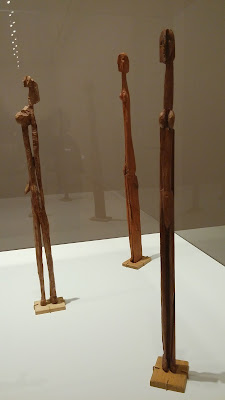
My main purpose in seeing the Picasso show at the MOMA in NYC was to see, in person, the ceramic work he did in the studio in Vallauris. Picasso took the vessels and forms made by a professional potter and altered and glazed them himself. There were a select few of these in the show.
There were small ones like this little "Seated Faun," It has an exuberant playfulness and spontaneity. We can see how it was
made - there are no secrets here.
The enormous looking bull succeeds at looking so big by virtue of his tiny head. He is all brawn,
with twinkling hoofs and simple circles where his haunches and shoulders are, I think he's very imposing yet humorous.
This jug is called, " Insect." I didn't see that at the time. To me it was a clever pun on handles. Three handles are on each side with hands painted on where they join the body of the pot. Perhaps it does depict an insect, I don't know, but I liked it for the bold painting and the six pairs of hands.
A wall of drawings were all of imagined sculptures very carefully rendered and shaded. Their technical neatness contrasts with the seemingly wild abandonment of structural technique in his sculpture.
Of the bronzes, this "Little Girl Jumping Rope," delighted me the most. Her basket body, clunky shoes and skinny legs suspended in air, she breezily skips over a twisted rope turned by two ridiculously short arms.
I wonder that more of us were not laughing aloud as we viewed this exhibit. How can we be serious-faced art lovers while looking at these wild creations? Yet we were, the hush of museum culture keeping our giggles and exclamations to subdued murmurs.
Just look at the face on this flat plywood "Bull." A knob for a nose, nailhead eyes and a lopsided gash for a mouth. These are playful works. They are fun!
The last sculptures I will include here are these, a group of wooden figures called, "The Bathers." Here are two with arms outstretched, perhaps enjoying the spray from the ocean. The scrap wood they are made from is sometimes painted or gouged to create for instance, ribs or penises (I think they are all naked bathers) there are six men, women and children in what the MOMA says is Picasso's only figure sculpture ensemble.
Primitive, rough, and bizarrely proportioned, these figures say to me that Picasso was a free-spirit, an unrestrained wild man in art.
Choosing to make use of odd scrapyard finds and to forge ahead with their graceless flat shapes, leaving in bent nails, accepting all the cracks and scuffs, he turned them into a monument, at least in scale and hutzpah, to the human figure at leisure. These sculptures were the last ones in the exhibit and date from the mid 1950's.
Allow me to reconsider and add one more sculpture to this posting, and it is a very small one. In one case, there was a display of stones that Picasso had engraved. These touched me because I recently made art out of pebbles like these. This "Face," from the mid 1940's is another example of the artist Picasso's attention and skill with a wide range of materials. It is simple, honest, and warm in feeling, one of the little joys in a grand yet accessible exhibit.
See it before it ends on February 7, 2016.


















